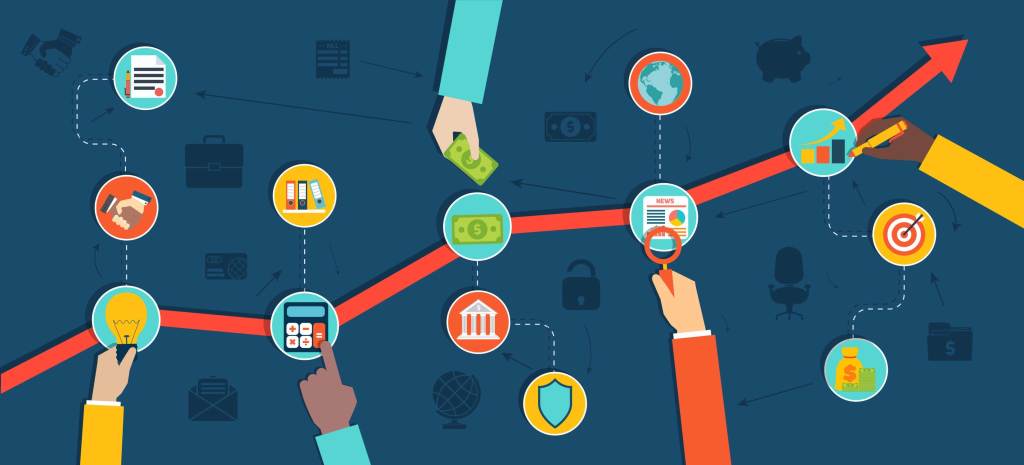
Do you remember learning about the food pyramid? My earliest memories of it were back in elementary school, when my teacher used it to teach us the essential building blocks of a healthy and balanced meal.
The US Department of Agriculture has since redesigned the pyramid and now uses a subdivided plate. This deceptively simple tool continues to teach kids and adults across the country how to maintain a nutritious and balanced diet. While we may not succeed in eating healthy every day, the food pyramid/plate helps us see what a healthy lifestyle looks like, and gives us specific examples of what it means to eat well. It takes the complexity of a person’s entire diet and breaks it down into parts that are easy to understand.
Why don’t we have a similarly straightforward guide that explains how a person can build and maintain their financial health? Financial health is just as essential to a person’s wellbeing as their physical health—indeed, the two often go hand-in-hand. Yet millions of Americans don’t understand the fundamentals of how to manage their finances, including credit. Many were not taught about these things at home or in school. And too often, this lack of knowledge leads to costly mistakes that can follow them for years.
As a former community bank president who served urban communities for more than 15 years, I saw firsthand how a lack of financial education, combined with some bad practices in the consumer financial industry, hurt Americans who were working hard to support their families. Customers who had good jobs would come to my bank for a loan, and often I could not help them because of their poor credit history. Far too often, they had made seemingly small or routine missteps—like being late on a credit card or mortgage payment—without understanding the consequences it would have for their credit, or how long it would take to repair the damage. Other consumers accepted loan offers that arrived in the mail—offers that were confusing at best, and at worst, predatory. In many cases, lenders would aggressively market an initial “teaser rate” to consumers, while burying the significantly higher “regular” interest rate, critical terms, and penalties in the fine print.
What I saw during my time in banking made me realize that we need to take our personal financial health more seriously, as individuals and as a nation. We need to treat it as seriously as our physical health. Taking lessons from the public health sector, we should rethink how we regulate, sell, and market consumer financial products, how we teach financial literacy, and how we promote financial responsibility and wellbeing.
As we do, here are five strategies for us to consider.
1. Require banks, credit card companies, and lenders to provide consumers with clear, succinct, and relevant information
Just like the Food and Drug Administration requires restaurants to post calorie counts of certain menu items, companies should be required to give consumers clear and straightforward disclosures about financial products, and describe the benefits and risks of these products in simple and easy-to-understand language. This is critical to improving consumers’ awareness of the obligations that accompany their financial choices. The Consumer Financial Protection Bureau is already making some progress on this front, working closely with industry. As then FDA Commissioner Margaret Hamburg argued when she first announced the new calorie count rules for restaurants in 2014, “people today expect clear information about the products they consume.” We shouldn’t expect anything less from the checking accounts, credit cards, and home and auto loans that we count on.
2. Create a national policy to raise Americans’ financial acumen
Let’s start by requiring financial education in schools, so that kids reach a basic level of financial literacy before they graduate junior high. While most school districts across the country teach and require some combination of health, PE, and sex education, few have financial literacy education integrated into their curriculums. It’s no wonder that fewer than half of US high school and college students have a regular savings plan, and only a quarter of them stick to a budget, according to a study by the American Savings Education Council. And research by the National Council on Economic Education gave half of US adults a failing grade for their knowledge of basic economic concepts. Yet according to the National Endowment for Financial Education, as few as ten hours of classroom instruction can be enough to help students improve their spending and saving habits.
3. Develop a certified seal of excellence for financial products
Similar to the Good Housekeeping Seal of Approval or Consumer Reports’ ratings system for products like washing machines, blenders, and cars, consumer financial products should be vetted and tested to confirm their performance in terms of health, safety, and trustworthiness. Today it is difficult for consumers to compare financial products and their various features, benefits, and penalties. Just like buying a microwave or toaster, we should shine a spotlight on financial products that are safe and high performers. Who should rate or certify these financial products? The Consumer Financial Protection Bureau or a private association would be good places to start.
4. Ban harmful financial products from the marketplace
To keep our citizens healthy, the government regulates cigarettes and alcohol, and sets age restrictions for who can buy them. Certain narcotics are entirely illegal while other types of drugs can only be obtained with a doctor’s prescription. Financial products with extremely punitive terms and risks (like payday loans and other short-term loans with interest rates, penalties and other terms that make repayment extremely unlikely) also hurt consumers. The government should consider banning or restricting them, including those products marketed and sold online.
5. Publish and teach financial guideposts to prepare consumers for different stages of their lives
Our financial needs change at critical life milestones. From high school and college graduation, to a person’s first job, marriage and starting a family—all the way through retirement—we should have guideposts for our financial health. Just like doctors check our physical health annually and provide guidelines for the types of medical tests and immunizations we need based on lifestyle and age, we should regularly evaluate our financial health at critical life milestones. So let’s provide common sense benchmarks for people to understand how much consumer debt is reasonable to carry, and how much they should be saving based on their income, life situation, and other factors.
When it comes to improving outcomes of a person’s life—making sure they’re able to achieve essential goals such as putting food on the table, paying for college, buying a home, and planning for the future— a good credit score and sufficient savings are as important as eating well and exercising regularly. It’s time for us to acknowledge that creating positive financial outcomes in the course of a person’s life should not be left to chance. So let’s make financial health a reality for all.



